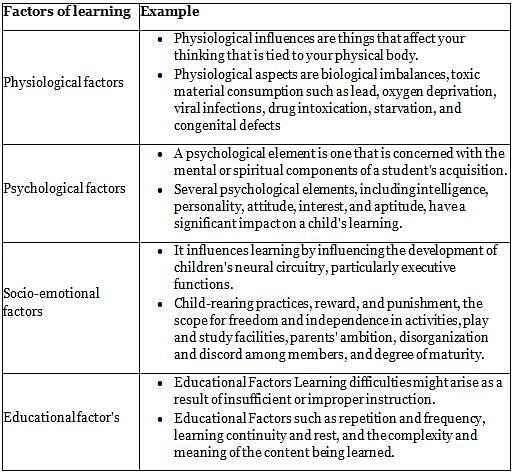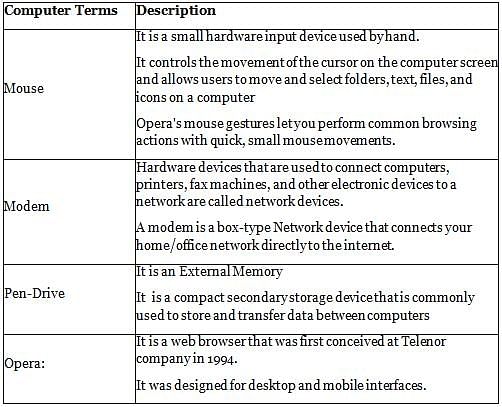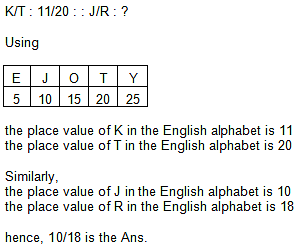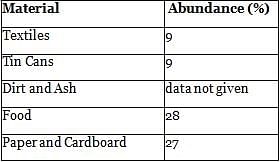UGC NET Paper 1 Practice Test - 7 - UGC NET MCQ
30 Questions MCQ Test UGC NET Mock Test Series 2024 - UGC NET Paper 1 Practice Test - 7
If a researcher conducts a research on finding out which administrative style contributes more to institutional effectiveness, it will be an example of
The flexible method in which a teacher can shift from one form of instruction to another in order to maintain the focus of students is known as:
Direction: Given below are two statements.
Statement I: Preadolescent children are unable to think abstractly or hypothetically.
Statement II: In the formal operational stage a child is able to use symbols related to abstract concepts.
In light of the above statements, choose the most appropriate answer from the options given below:
The primary responsibility for the teacher's adjustment lies with the
Match List I with List II.

Choose the correct answer from the options given below:
Which among the following gives more freedom to the learner to interact?
Direction: Read the following statements – one labeled as Assertion (A) and the other as Reason (R)
Assertion (A): Qualitative research in India has a long way to go to reach international standards.
Reason (R): Because the funding agencies do not support qualitative research in academic institutions.
Find the correct answer from the codes given below:
Direction: Given below are two statements.
Statement I: The goal of inquiry in fundamental research is directed at bringing an increment in the fund of knowledge.
Statement II: Action research is research by the practitioner, for the practitioner, and of the practitioner.
In light of the above statements, choose the correct answer from the options given below:
Directions: Read the following passage carefully and answer the question.
The phrase “What is it like?“ stands for a fundamental thought process. How does one go about observing and reporting on things and events that occupy segments of earth space? Of all the infinite variety of phenomena on the face of the earth, how does one decide what phenomena to observe? There is no such thing as a complete description of the earth or any part of it, for every microscopic point on the earth’s surface differs from every other such point. Experience shows that the things observed are already familiar, because they are like phenomena that occur at home or because they resemble the abstract images and models developed in the human mind.
How are abstract images formed? Humans alone among the animals possess language; their words symbolise not only specific things but also mental images of classes of things. People can remember what they have seen or experienced because they attach a word symbol to them.
During the long record of our efforts to gain more and more knowledge about the face of the earth as the human habitat, there has been a continuing interplay between things and events. The direct observation through the senses is described as a percept; the mental image is described as a concept. Percepts are what some people describe as reality, in contrast to mental images, which are theoretical, implying that they are not real.
The relation of Percept to Concept is not as simple as the definition implies. It is now quite clear that people of different cultures or even individuals in the same culture develop different mental images of reality and what they perceive is a reflection of these preconceptions. The direct observation of things and events on the face of the earth is so clearly a function of the mental images of the mind of the observer that the whole idea of reality must be reconsidered.
Concepts determine what the observer perceives, yet concepts are derived from the generalisations of previous percepts. What happens is that the educated observer is taught to accept a set of concepts and then he/she sharpens or changes these concepts during a professional career. In any one field of scholarship, professional opinion at one time determines what concepts and procedures are acceptable, and these form a kind of model of scholarly behaviour.
Q. According to the passage, human beings have mostly in mind
Directions: Read the following passage carefully and answer the question.
The phrase “What is it like?“ stands for a fundamental thought process. How does one go about observing and reporting on things and events that occupy segments of earth space? Of all the infinite variety of phenomena on the face of the earth, how does one decide what phenomena to observe? There is no such thing as a complete description of the earth or any part of it, for every microscopic point on the earth’s surface differs from every other such point. Experience shows that the things observed are already familiar, because they are like phenomena that occur at home or because they resemble the abstract images and models developed in the human mind.
How are abstract images formed? Humans alone among the animals possess language; their words symbolise not only specific things but also mental images of classes of things. People can remember what they have seen or experienced because they attach a word symbol to them.
During the long record of our efforts to gain more and more knowledge about the face of the earth as the human habitat, there has been a continuing interplay between things and events. The direct observation through the senses is described as a percept; the mental image is described as a concept. Percepts are what some people describe as reality, in contrast to mental images, which are theoretical, implying that they are not real.
The relation of Percept to Concept is not as simple as the definition implies. It is now quite clear that people of different cultures or even individuals in the same culture develop different mental images of reality and what they perceive is a reflection of these preconceptions. The direct observation of things and events on the face of the earth is so clearly a function of the mental images of the mind of the observer that the whole idea of reality must be reconsidered.
Concepts determine what the observer perceives, yet concepts are derived from the generalisations of previous percepts. What happens is that the educated observer is taught to accept a set of concepts and then he/she sharpens or changes these concepts during a professional career. In any one field of scholarship, professional opinion at one time determines what concepts and procedures are acceptable, and these form a kind of model of scholarly behaviour.
Q. The relation of Percept to Concept is
Direction: Read the following excerpt and answer the questions asked at the end. The answers to the questions should be based on the excerpt.
Although water covers approximately sixty seven percent of the Earth's surface, of this less than three percent is fresh water. Accounting for fresh water locked in glaciers, ice-caps or otherwise inaccessible, less than a tenth of a percent of the Earth's water is available for human consumption. Pollution, population growth and wasteful irrigation practices are contributing to a worldwide water shortage. When the clear precious liquid becomes scarce, countries begin to assert claims on fresh water supplies. As a result, drinkable water has become a region of conflict that could eventually lead to greater hostilities between nations.
Some countries such as the United States, have ample sources of water. In other nations, such as China, water is less plentiful. As water resources dwindle, competition for available sources will rise. Nations may claim rights to a particular body Of fresh water or they may plan to build dams and other projects on rivers. If two or more nations which disagree on water rights or building projects, conflicts can emerge. In order to combat this issue many countries are adopting water conservation and security solutions. The United Nations has implemented programs to combat potential issues that could lead to violence.
Q. What percent of the surface of the earth covered with water, is available for human consumption?
Direction: Read the following excerpt and answer the questions asked at the end. The answers to the questions should be based on the excerpt.
Although water covers approximately sixty seven percent of the Earth's surface, of this less than three percent is fresh water. Accounting for fresh water locked in glaciers, ice-caps or otherwise inaccessible, less than a tenth of a percent of the Earth's water is available for human consumption. Pollution, population growth and wasteful irrigation practices are contributing to a worldwide water shortage. When the clear precious liquid becomes scarce, countries begin to assert claims on fresh water supplies. As a result, drinkable water has become a region of conflict that could eventually lead to greater hostilities between nations.
Some countries such as the United States, have ample sources of water. In other nations, such as China, water is less plentiful. As water resources dwindle, competition for available sources will rise. Nations may claim rights to a particular body Of fresh water or they may plan to build dams and other projects on rivers. If two or more nations which disagree on water rights or building projects, conflicts can emerge. In order to combat this issue many countries are adopting water conservation and security solutions. The United Nations has implemented programs to combat potential issues that could lead to violence.
Q. Which of the following could be the probable reason for hostility among nations in the future?
Direction: Read the following excerpt and answer the questions asked at the end. The answers to the questions should be based on the excerpt.
Although water covers approximately sixty seven percent of the Earth's surface, of this less than three percent is fresh water. Accounting for fresh water locked in glaciers, ice-caps or otherwise inaccessible, less than a tenth of a percent of the Earth's water is available for human consumption. Pollution, population growth and wasteful irrigation practices are contributing to a worldwide water shortage. When the clear precious liquid becomes scarce, countries begin to assert claims on fresh water supplies. As a result, drinkable water has become a region of conflict that could eventually lead to greater hostilities between nations.
Some countries such as the United States, have ample sources of water. In other nations, such as China, water is less plentiful. As water resources dwindle, competition for available sources will rise. Nations may claim rights to a particular body Of fresh water or they may plan to build dams and other projects on rivers. If two or more nations which disagree on water rights or building projects, conflicts can emerge. In order to combat this issue many countries are adopting water conservation and security solutions. The United Nations has implemented programs to combat potential issues that could lead to violence.
Q. What would be the most effective solution to avoid future conflicts among the nations?
The type of communication that the teacher has in the classroom, is termed as
Effective public speaking begins with Five Essential Vocal Tools. These are:
- Energy and emphasis
- Pitch inflection
- Vocabulary
- Rhythm and pacing
- Pauses and silence
- Vocal quality
Choose the correct answer from the options given below:
When communicated, institutionalised stereotypes become
Match List I with List II:

Choose the correct answer from the options given below:
Classroom communication of a teacher rests on the principle of
Match List I with List II.

Choose the correct answer from the options given below:
The letters in the first set have a certain relationship. On the basis of this relationship, make the right choice for the second set:
K/T : 11/20 : : J/R : ?
In respect of computer software, features of a typical operating system include:
A. The interface‐allowing communication between the user and the computer
B. Memory management‐allocating internal memory (RAM) to programs and data in use and retrieving and storing data on the external memory devices
C. Resource handling‐controlling peripheral devices (input and output devices) and handling user requests for peripheral devices
D. Internet access‐providing connectivity to the services on the Internet
Choose the correct answer from the options given below:
Directions: In making decisions about an important question, it is desirable to be able to distinguish between 'strong' arguments and 'weak' arguments. 'Strong' arguments are those which are both important and directly related to the question. 'Weak' arguments are those which are of minor importance and also may not be directly related to the question or may be related to a trivial aspect of the question.
The given question is followed by arguments numbered I and II. You have to decide which of the arguments is/are 'strong' argument(s) and which is/are 'weak' argument(s) and mark your answer accordingly.
Should Indian government invest more time and resources to collect data, on the basis of which GDP (Gross Domestic Product) is calculated?
Arguments:
I. Yes, there is no good way yet to collect data from the hundreds of millions of establishments that constitute the production sector of our economy.
II. No, it would just take too long and cost too much, especially since much of the production sector of our economy keeps no records.
In which of the methods of teaching ICT support is implied?
Directions: On the basis of the data given in the following table, answer the question.
Government Expenditures on Social Services
(As percent of total expenditure)
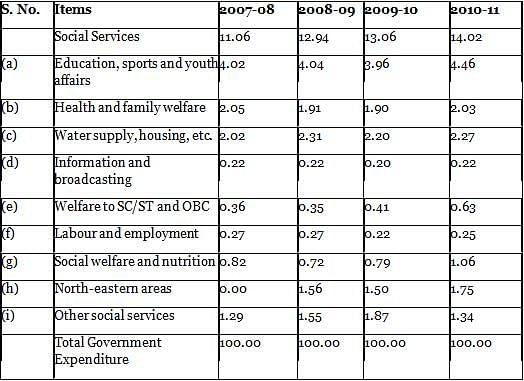
Q. In which year have the expenditures on the social services increased at the highest rate?
Directions: On the basis of the data given in the following table, answer the question.
Government Expenditures on Social Services
(As percent of total expenditure)

Q. Which of the following items' expenditure share is almost equal to the remaining three items in the given years?
Arrange the following components of municipal solid waste in order of their increasing abundance.
A. Paper and Cardboard
B. Food
C. Tin Cans
D. Dirt and Ash
E. Textiles
Choose the correct answer from the options given below:
Directions: The given statement is followed by two assumptions numbered I and II. An assumption is something supposed or taken for granted. You have to consider the statement and the following assumptions to decide which of the assumptions is/are implicit.
Statement: That interaction can be pleasant even if it's over a point of difference appears to have turned into an historical artefact.
Assumptions:
I. It is less common to see people involved in displeasing communication over some point or the other.
II. People normally get furious over a point of difference and lose their control over words.
Noise pollution is created if the sound is in excess to:
|
16 docs|120 tests
|



